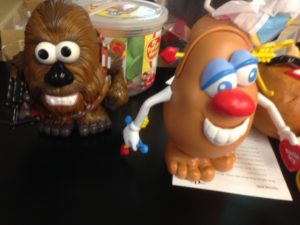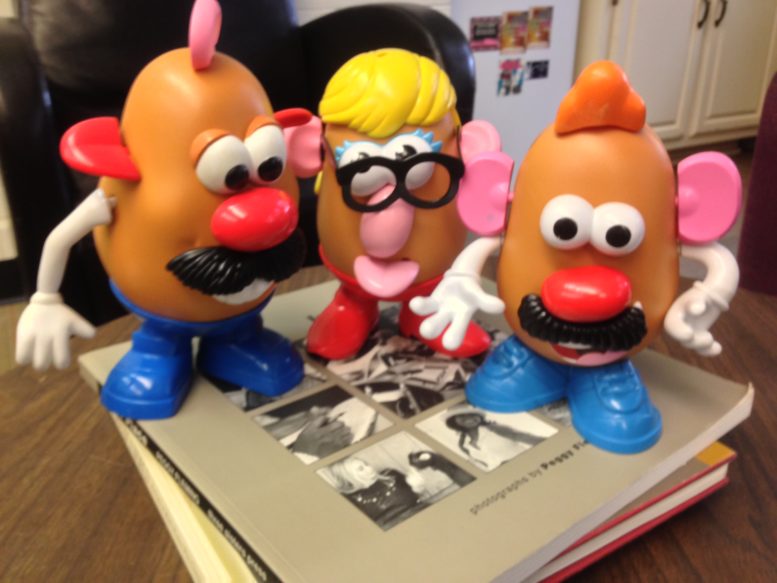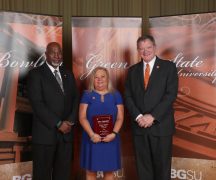By DAVID DUPONT
BG Independent News
Mr. Potato Head has had a storied career.
The pop culture icon has been a beloved toy, a movie star, a “Spokes-spud” for physical fitness and the Great American Smokeout. He’s encouraged consumers to buy Burger King fries and citizens to vote.
Now, Mr. Potato Head and his wife, Mrs. Potato Head, have become Bowling Green State University Falcons.
 Thanks to a donation by Matthew Wilson, of Michigan, a collection Mr. and Mrs. Potato Head toys have taken up residence in the Popular Culture Library on campus.
Thanks to a donation by Matthew Wilson, of Michigan, a collection Mr. and Mrs. Potato Head toys have taken up residence in the Popular Culture Library on campus.
In February, Nancy Down, head of the Popular Culture Library, and Alissa Butler, a doctoral student in American Culture Studies, gave a talk at the Women’s Center on campus to discuss the history of Mr. and Mrs. Potato Head and their roles in popular culture.
Mr. Potato Head was born, the brainchild of inventor George Lerner, fully formed with bushy mustache in 1952. “Mr. Potato Head is the best friend a boy or girl could have,” the original ads promised, Down said. Mr. Potato Head was the first toy advertised on television. His wife arrived a year later followed by offspring, Spud and Yam. At first they were sold as disembodied features, noses, eyes, mustaches, hair, and shoes. Kids had to supply their own potatoes or other vegetable of their choice. The plastic body was introduced in 1964.
The spud couple were epitomes of 1950s consumer culture. They had two cars – his with a boat trailer, hers with a shopping cart. They had a boat and a plane. They even had a train. “How many couples in the ‘50s had their own locomotive?” Down wondered.
They stuck to the established gender roles. Mrs. Potato Head was her husband’s dutiful helpmate. She had her ever present purse, and fancy hat. He had a jack hammer, she had a feather duster.
Though the accessories and detachable parts were interchangeable, the packaging was color coded to make clear which gender the toys were intended for, Down said.
Only Mr. Potato Head was inducted into the Toy Hall of Fame in 2000, the third class of inductees. Given her character, though, his wife surely would have been proud of him, but would have cautioned him not to let it go to his head.
By then the Potato Heads had emerged from the toy chest. He ditched his pipe for the Great American Smokeout. Urged people not to be couch potatoes for the Presidential Council for Physical Fitness and promoted the importance of voting to kids in a campaign sponsored by the League of Women Voters and Wal-Mart. He also appeared in political ads in the 1988 campaign after vice presidential candidate Dan Quayle famously misspelled “potato.”
The Potato Heads landed a television show, but their most famous screen time came in the “Toy Story” movies.
Mr. Potato Head, voiced by Don Rickles, played a major role in the first movie. He was, explained Butler, a fully formed, if static character.
He was the “surly, sarcastic” member of the gang in Andy’s room (and the only licensed product), quick with a cutting remark, and always expecting the worst.
Butler said that while not completely free of problems, the Pixar movies had a more enlightened view of gender roles than typical of those made by parent company Disney. Bo Peep, while Woody’s love interest, did stand up for herself, and was willing to call out Woody when he was wrong. And, as someone in the audience noted, she had a job tending her flock of sheep.
Mrs. Potato Head is introduced in the final scene of the first movie as a Christmas gift for Andy’s sister – not Andy, Butler noted – much to Mr. Potato Head’s delight.
In the next two movies she plays a larger role, but always remains subservient to Mr. Potato Head. She’s either scolding him or fussing over him. When he heads off on a rescue mission, she chides him to remember his “angry eyes.”
This is played up by casting Estelle Harris, an actress who often played nagging wives on TV, as her voice.
Butler noted in the third movie, Mrs. Potato Head confronts the bad guy Lotso. “She finally has this moment of agency, stands up for herself, stands up for her people.” But she asserts her value through consumerism. “I come with 30 accessories. I deserve respect.”
Then Lotso snatches away her lips, to which her husband responds, only he can take his wife’s lips away. This exchange is disappointing, Butler said. A woman speaks up, is silenced, and the only objection is another man asserting it is his place to silence her.
Butler said this contrasts with the treatment of other female characters. Barbie, she said, whom a viewer would expect to be an exemplar of traditional gender roles, plays an active part in helping the toys escape from Lotso’s clutches. She uses guile to meet up with former boyfriend Ken (“they were literally made for each other”) and then muscle to overpower him.
“While the ‘Toy Story’ movies have several, strong independent women characters,” Butler concluded,”Mrs. Potato Head is not one of them.”
Still she and her husband are “shown to have a healthy, positive relationship,” Butler said. A running gag is that a wall will fall down to reveal the couple kissing.
Butler said she’s interested in seeing how the Potato Heads fare in the forthcoming “Toy Story 4.”





